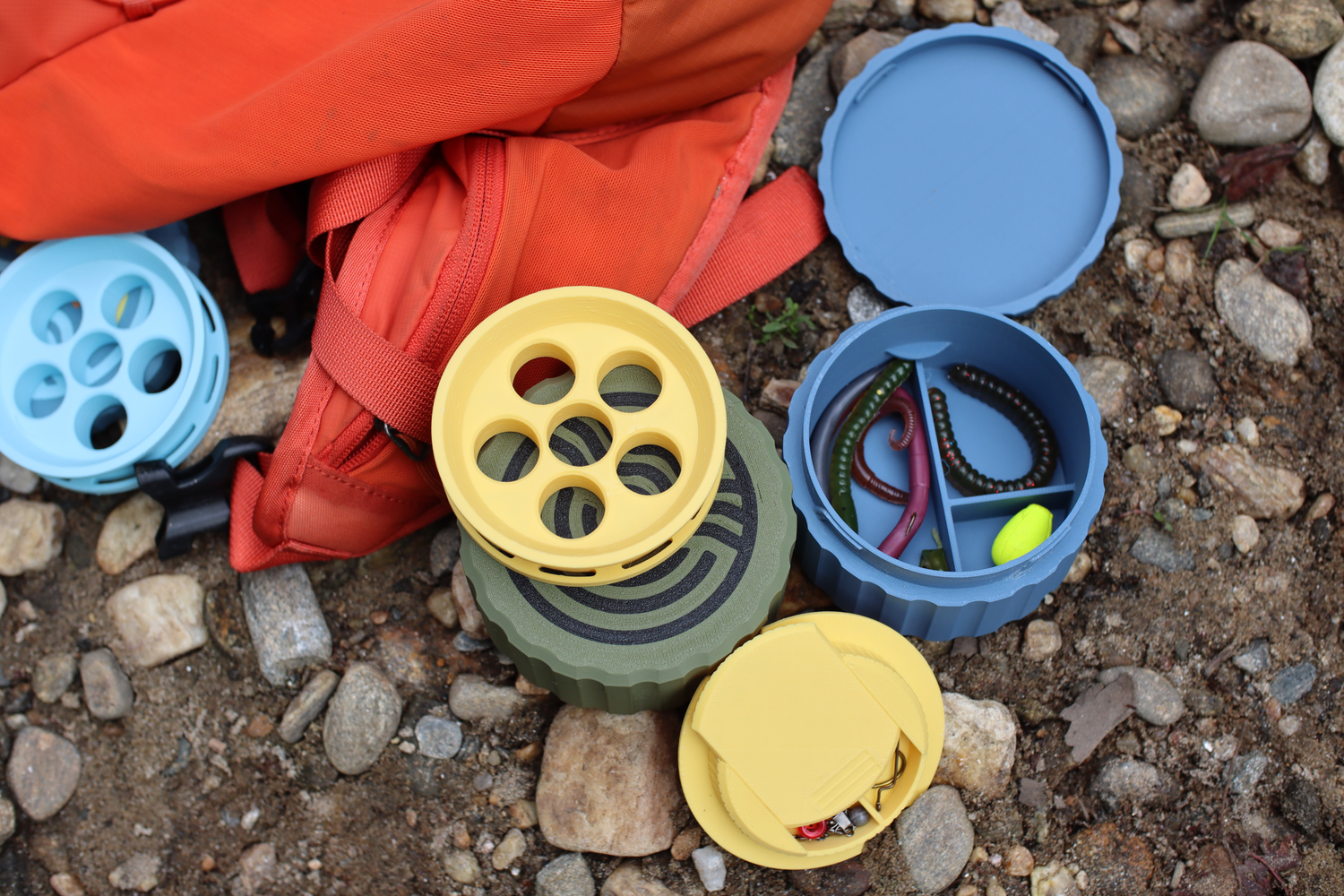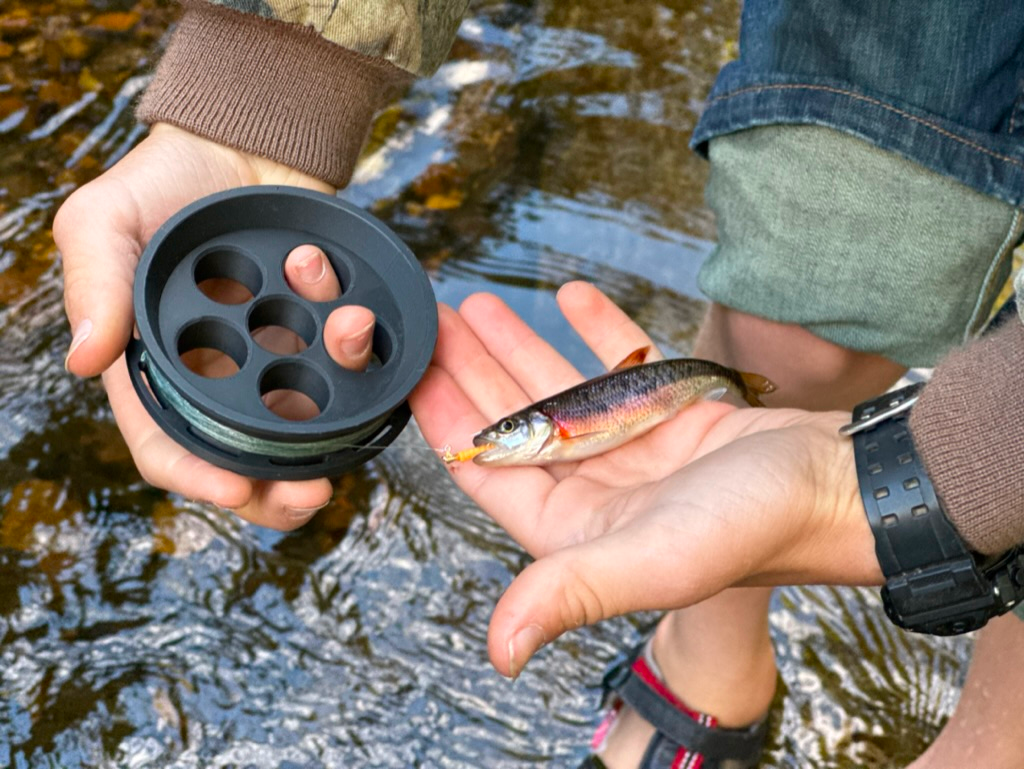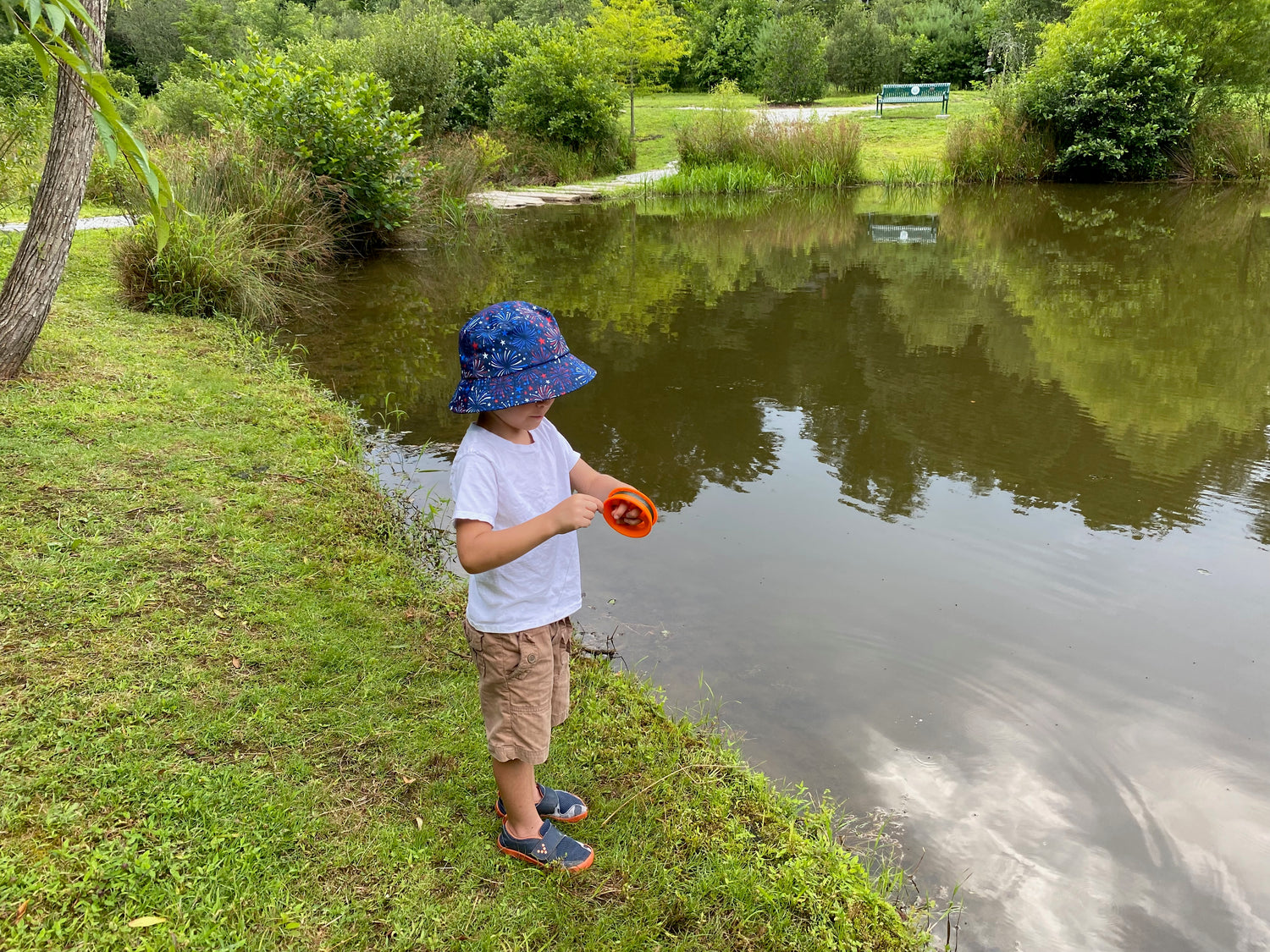Next time your buddies laugh about the size of the fish you caught, just tell them that you’re microfishing. It’s the truth! (Kind of).
Actual microfishing is the idea of catching small fish intentionally, targeting species like creek chub, dace, warpaint shiners, and darters that cannot be caught with regular fishing gear due to their tiny size. Anglers worldwide have become fascinated with the challenge of catching these elusive species of fish, because it requires specialized gear like small hooks and unique techniques to catch them.
While microfishing originated in Japan as Tanago fishing, the interest has grown globally, and anglers worldwide are now chasing these tiny fish with excitement. This burgeoning interest has sparked the creation of specific gear and techniques, which we will discuss in this blog post, paving the way to mastering the art of microfishing.
Catching tiny fish for fun
Microfishing allows you to experience the world of fishing in a unique and enjoyable way, targeting the smallest fish species and challenging yourself to catch what most people overlook.
You can focus on the excitement and satisfaction of catching these tiny fish by using specialized gear such as Tanago hooks, hand reels, homemade rods, or no rods at all.
Whether you’re a seasoned angler craving a fresh challenge or a novice venturing into the fishing realm, micro fishing promises a gratifying and exhilarating experience for all.
The angling world's fascination with micro fish
The increasing interest in microfishing can be attributed to the unique challenge it presents and the opportunity to explore a lesser-known aspect of the angling world.
Microfishing has its roots in Japan’s Tanago fishing, where the goal is to catch the smallest fish possible – one that fits entirely on a one-yen coin.
As the fascination with micro fishing spreads globally, anglers outside Japan have embraced the challenge of catching these tiny fish, leading to the development of specialized gear and techniques that cater to this growing niche within the angling community.
Here in Western North Carolina, we love exploring the tiny rivers, creeks, and streams under a canopy of low-hanging rhododendrons, searching for a good place for tiny catches.
The Diverse Species of Micro Fish
While the size of the fish might be small, the experience of catching them and the thrill of discovering new species can be monumental.
Let’s look into some of the fascinating micro-fish species that populate (our) North Carolina's waters:
-
Least Killifish (Heterandria formosa): Often mistaken for baby fish of larger species, the Least Killifish is native to North Carolina and is one of the smallest live-bearing species. Males rarely exceed an inch in length, and females are only slightly larger. They thrive in slow-moving streams and marshy habitats.
-
Dusky Shiner (Notropis cummingsae): Commonly found in the streams and rivers of North Carolina, the Dusky Shiner is a small, silver-colored fish with a dark lateral line. Their preferred habitat includes clean, flowing waters with sandy or gravelly bottoms.
-
Tesselated Darter (Etheostoma olmstedi): These tiny benthic fish are adorned with a series of dark, rectangular blotches that give them their name. Preferring cool, clear streams with rocky substrates, they are often a delightful find for micro-anglers.
-
Bluefin Killifish (Lucania goodei): Sporting iridescent blue stripes, the Bluefin Killifish is a beauty to behold. They're typically found in the coastal plains of North Carolina, residing in vegetated areas of swamps, ponds, and slow-moving streams.
-
Carolina Pygmy Sunfish (Elassoma boehlkei): A true gem of North Carolina waters, this diminutive sunfish boasts stunning colors, especially during spawning season. They're often found in acidic waters, like blackwater swamps and vegetated ponds.
-
Brook Silverside (Labidesthes sicculus): These slender, translucent fish can be found in many of North Carolina's lakes and larger rivers. They swim near the surface and have a distinctive silver stripe running laterally from head to tail.
- Warpaint Shiner (Luxilus coccogenis): Named for its striking coloration, the Warpaint Shiner is a sight to behold with its vibrant red and black markings, reminiscent of war paint. Native to North Carolina, they are commonly found in clear, cool streams with rocky substrates. Their vibrant colors, especially in males during the breeding season, make them a sought-after species for micro-anglers in the region.

While they might not provide the same fight as larger fish, the joy of micro-fishing lies in the discovery of these small family of darters.
Essential Micro Fishing Gear
Achieving success in micro fishing hinges on possessing suitable gear, including small hooks, rodless hand reel kits, and rigging essentials specifically crafted to meet the unique demands of capturing miniature fish.
With the right gear in hand, you’ll be well-prepared to tackle the exciting world of microfishing and catch those elusive micro fish.
Small hooks: Tanago hooks and other options
Small hooks are indispensable for microfishing, given their unique design to ensnare tiny fish with minuscule mouths.
Tanago hooks are a popular choice, as they come tied to a clear leader line, making it easy to attach to your fishing line and start catching micro fish.
Other options include Micro Trout Magnet hooks, which can also be effective for targeting small fish species.
Regardless of your hook choice, selecting the appropriate smallest hook is pivotal for successful micro fish capture.
Rodless hand reel kits
Rodless hand reel kits, like the GoReel Hand Reel Fishing Kit, are a fantastic option for microfishing in creeks and streams. Here's a closer look at the benefits these mini fishing kits provide:
- Portability: One of the main attractions of a rodless hand reel kit is its compact size. Easy to pack and carry, it's the ultimate travel companion for the wandering fisherman. Whether you're hiking to a remote stream or just heading to a nearby creek, the lightweight and streamlined design ensures it won't weigh you down.
- Precision: Microfishing is all about the details. With a rodless hand reel, you gain a direct feel for what's happening underwater, allowing you to detect even the subtlest nibble. This heightened sensitivity ensures you don't miss out on any potential catch.
- Control: Unlike traditional rods, hand reels give you a direct line to the fish, allowing for an unmatched level of control. You can easily adjust the depth, speed, and movement of your bait, increasing your chances of success.
- Versatility: The beauty of the GoReel Hand Reel Fishing Kit lies in its adaptability. Suitable for various environments, from tranquil ponds to rushing streams, it's a tool that can handle diverse fishing scenarios. The absence of a rod means fewer entanglements and smoother transitions between spots.
- Cost-effectiveness: For those new to microfishing or those who do not want to invest heavily initially, rodless hand reel kits offer an affordable entry point. They provide excellent value for money without compromising on performance.

These micro-fishing kits are not just a tool but ideal for those spontaneous fishing adventures. A rodless hand reel kit facilitates the exploration of diverse micro-fishing locations, adding to the fun of catching tiny fish in varied ecosystems without the tangle of a traditional rod.
Line, split shot, and rigging essentials
Appropriate line, split shot, and rigging constitute the backbone of successful micro fishing, ensuring effective and accurate presentation of your bait to the target species.
Using the right line, such as a high-quality braided fishing line, will allow for better casting distance and accuracy.
Additionally, the correct split shot weight will help keep your bait in the perfect spot, while the appropriate rigging will ensure that your setup is optimized for catching those elusive micro fish.
With the GoReel Hand Reel Fishing Kit, you can enjoy the thrill of micro fishing anytime, anywhere.
Bait and Techniques for Micro Fishing Success
Testing out various natural and artificial baits will help in landing one or two of these river micros. This includes understanding the effectiveness of both natural and artificial baits, as well as learning tips for enticing bites and setting the hook.
Natural baits: Worms, insects, and larvae
Natural baits like worms, insects, and larvae can be extremely effective in attracting micro fish. These baits provide a familiar texture, odor, and appearance that can entice fish to bite.
Some of the best natural baits for microfishing include:
- Redworms
- Garden worms
- Live earthworms
- Fresh shrimp
- Squid
- Spikes/maggots
- Fresh bread
- Sweetcorn
Employing a range of natural baits augments your chances of triumph in micro fishing, ensuring you’ve caught plenty.
Artificial baits: Micro jigs and flies

Artificial baits, such as micro jigs and flies, can also be highly effective in microfishing. These baits are designed to mimic natural food items and can be used repeatedly, making them a practical and cost-effective option for microfishing.
Some top recommended artificial baits for microfishing include:
- Berkley Gulp Maggots
- Sunlure Mini Crankbait Fishing Lures
- Mini Trout Magnets
- Eurotackle ultralight soft lures.
Experimenting with diverse artificial baits helps you discover the ideal blend to tempt your target micro fish species.
Tips for enticing bites and setting the hook
When it comes to enticing bites and setting the hook in microfishing, there are several techniques that can lead to success. Some helpful tips for enticing bites and setting the hook include:
- Use the right bait and cast in the right spot
- Set the hook quickly once you feel a bite
- Use a trout float rig with a bobber and split shot
- Use small hooks designed for small fish or fly-tying hooks
- Bait the hook with small pieces of worms
Discovering Great Micro Fishing Locations
Finding the perfect micro-fishing location is crucial to a successful and enjoyable experience. Some of our favorite places to fish are creeks and streams that you can just about jump over.
We've found that these small water sources are a great place to catch micros.
Identifying prime habitat for small fish species
Recognizing the ideal habitats for various small fish species is essential to successful microfishing. Prime habitats often include:
- submerged vegetation
- gravel or mud bottoms
- large woody debris
- rocky habitats with attached plants and animals
These habitats provide suitable environments for various species of fish, including micro fish.
It’s important to understand the specific needs of your target species and identify locations that provide the necessary resources for their survival.
Good places to start: Trout streams, darter habitats, and minnow pools
If you’re new to microfishing, some great places to start include trout streams, darter habitats, and minnow pools.
These locations often provide the ideal conditions for small fish species and can be the perfect starting point for your micro-fishing journey.
As you gain experience and develop your skills, you can explore other habitats and locations to expand your micro-fishing knowledge and expertise.
Each discovery, no matter how small, adds to the tapestry of our understanding and appreciation of the natural world.
By equipping yourself with the right gear, mastering the use of various baits and techniques, and discovering great micro-fishing locations, you can embark on a thrilling and rewarding micro-fishing journey.
So, grab your gear, head out to your nearest creek or stream, and dive into the exciting world of microfishing!
Frequently Asked Questions
What is micro fishing?
Microfishing is an exciting activity that originated in Japan, where anglers pursue small and overlooked fish species like minnows, dace, darters, and sculpins for the size and variety of species caught.
What bait to use for microfishing?
For microfishing, try using a small hook with a tiny piece of worm or white bread for bait. Alternatively, use a small fly - you'll be amazed by the results!
How do I start Microfishing?
Start microfishing by heading to a stream with the smallest hook you have - use a tiny piece of worm or a small fly for bait and cast your line. You could be catching micro fish in no time!
What is ultralight fishing?
Ultralight fishing is a fun way to challenge yourself with light lines and lures, typically between 1 lb. - 6 lb. test and lures ranging from 1/64 oz. Try it and see if you can catch the big one!
What is the ideal habitat for micro fish species?
Micro fish species thrive in habitats with submerged vegetation, gravel or mud bottoms, and large woody debris - a perfect combination for your tank!





